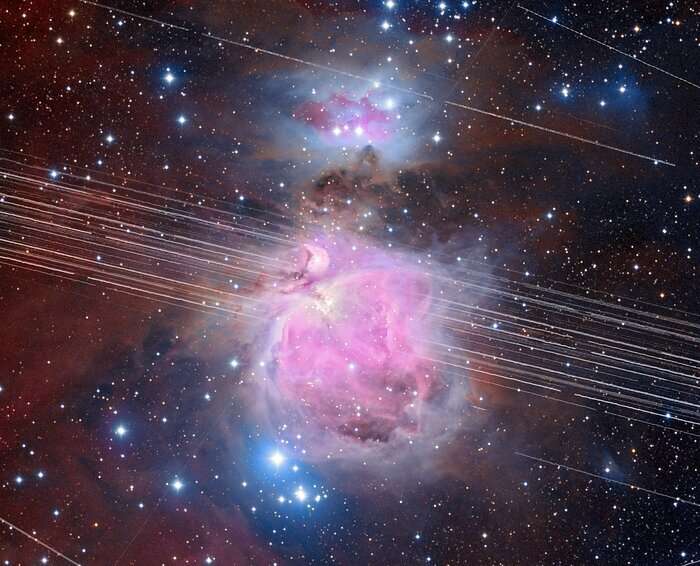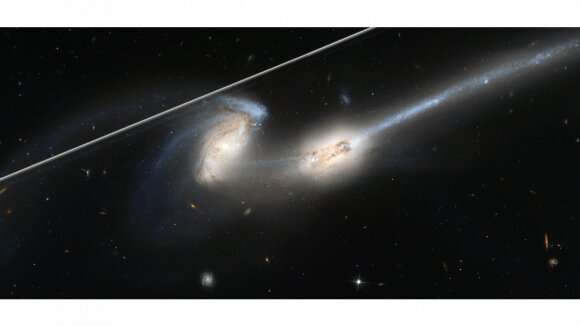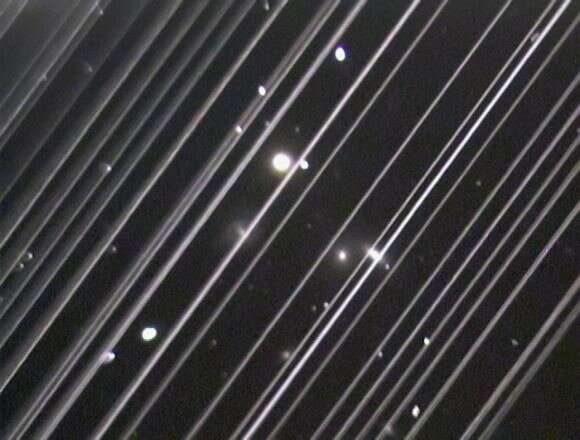This article has been reviewed according to Science X's editorial process and policies. Editors have highlighted the following attributes while ensuring the content's credibility:
fact-checked
trusted source
proofread
Astronomers have figured out clever tricks to reduce the impact of satellite trails

A clear sky is a prerequisite for most astronomers imaging the cosmos. However, with the proliferation of satellite trails, astronomers see a lot more streaks in their images. That's particularly true for people using professional ground-based and orbiting telescopes. When Hubble Space Telescope opened its eye on the sky, there were less than 500 satellites orbiting our planet. Now, there are nearly 8,000 of them, leaving their mark across the sky.
The pencil-thin streaks in HST images have the potential to "eclipse" a crucial target. Or, they might ruin an entire observing run. The telescope is not cheap to run, so a photobombed observation costs the taxpayers plenty of money. So, what do HST astronomers do if a satellite streak appears?
It turns out satellite trails are not as much of an issue for that telescope as they are for others. That's because there's a trick available for HST image calibration, according to Dave Stark at STScI. "We developed a new tool to identify satellite trails that is an improvement over the previous satellite software because it is much more sensitive. So we think it will be better for identifying and removing satellite trails in Hubble images," he said.
The tool Stark is using is based on an extensive image analysis technique called Radon Transform. It's a mathematical "trick" similar to the Fourier transform. Both can be applied to reconstruct images. And, that means the satellite tracks are not a huge threat to the telescope's continued observations—at the moment.
Stark applied the tool to satellite trails across Hubble's Advanced Camera for Surveys (ACS). Each Hubble science observation comes from a collection of multiple exposures on the same celestial target. A satellite crossing the field of view generally appears in one frame, and not the next consecutive frame. About ten percent of HST's observations today are affected by satellite trails.
"The average width I measured for satellites was 5 to 10 pixels," said Stark. "The ACS's widest view is 4,000 pixels across, so a typical trail will affect less than 0.5% of a single exposure. So not only can we flag them, but they don't impact the majority of pixels in individual Hubble images. Even as the number of satellites increases, our tools for cleaning the pictures will still be relevant."

Finding and masking satellite trails
Stark and collaborators developed a masking routine that identifies where the bad pixels are, the extent to which they affect the image, and then calls them out. "When we flag them, we should be able to recover the full field of view without a problem, after combining the data from all exposures," said Stark.
As it stands, the software tool sums up all the light along every possible straight path across a given HST image. In this way, it identifies and characterizes linear features in an image. This approach combines all the light from a satellite trail, making it "pop out" in the transformed image. This approach works even for those that are very faint in the original image. It joins an extensive catalog of tools that astronomers have used for years to "clean up" HST observations.

What about ground-based telescopes and satellite trails?
The same satellites that plague HST give astronomers pause when it comes to observing with professional ground-based telescopes. It turns out that they can adapt to the mega-constellations. However, it's going to require quite a lot of telemetry data about those satellites. This would allow astronomers to "program around" the satellites when planning their observations. And, most facilities will need to work out similar mathematical workarounds to fix images after the fact.
Clearly, it makes a lot of sense to mitigate the effects of satellites so that they don't pose such a big challenge to astronomy. There have also been suggestions that satellite system operators try to limit the visibility of their space-based assets so that the streaks aren't so obvious.
What's the ultimate effect of those satellites on ground-based facilities? As an example, operators of the Vera C. Rubin telescope in Chile fear that at least 30% of that telescope's observations will be affected by satellite streaks. That's particularly challenging since the telescope is being built to observe everything from distant (and very faint) galaxies to potentially threatening near-Earth asteroids. The Rubin staff are working with SpaceX engineers (for example) to figure out ways to mitigate the impacts of Starlink satellites. In addition, they'll have to figure out software workarounds just as HST personnel are doing for their observations.
Industry guidelines to avoid satellite trails
There are some established guidelines that could help mitigate satellite trails for a wide range of facilities. In addition to darkening satellite reflectivities and providing accurate telemetry, they include keeping orbital altitudes below 600 km (to reduce the number of satellites visible later into the night), orienting reflective surfaces such as solar panels so that they don't reflect sunlight back to Earth, and reducing the numbers of satellites.
Adopting all the guidelines to mitigate satellite trails should, in theory, make imaging the night sky a bit easier for everybody, while still accommodating the growing need for the services these satellite constellations provide.
Provided by Universe Today





















